| Pages:
1
2 |
Dan Vizine
National Hazard
   
Posts: 628
Registered: 4-4-2014
Location: Tonawanda, New York
Member Is Offline
Mood: High Resistance
|
|
Molten Europium
I recently purchased 25 grams of europium from Metallium. The "sample photo" showed a piece of solid, massive metal. The delivered material was
actually fine dentritic material, black everywhere, and nothing like the "sample". There was no mechanical way to salvage any solid piece, it was just
a mess. The mineral oil was washed off with dried xylenes. Since the high surface area made handling very difficult, the first step was compaction in
a mold in my hydraulic press. The resultant cylinder, after drying in vacuo is shown in the rbf. Ugly, isn't it?
Since europium melts so low (<900 C), I thought I'd capitalize on the separation of oxides from clean metal that results from melting.
The question then became "what do I melt it in?". When europium is isolated, the oxide is heated with lanthanum. The Eu vapors condense on tantalum.
"Condensing on" and "melting in" are often not the same. Tantalum might work. But, I had no Ta sheet. I had Mo sheets and so I bent edges up to make a
small boat which would fit into a quartz tube. I was hoping;
a) That molten Eu wouldn't wet Mo
b) That molten Eu would have some semblance of viscosity
I fitted a tube furnace with a 1" quartz tube, blew UHP argon through at 1.5 SCFH and heated the clean tube and pan to 900 C and then cooled under
argon.
A small slab, perhaps 5 grams was loaded into it and it was put into the tube. After purging for another 5 minutes the tube was put into the
pre-heated furnace. After a couple minutes I noticed a grey film condensing in the cool part of the tube. I looked at the sample and it was silvery
everywhere (see pic in furnace).
I slid the part of the tube with the boat so the boat was outside the furnace. Upon cooling under argon, the surface darkened (not shown). Well, I
guess the option is to melt it.
I watched very closely as melting started. Damnit! Molten Eu flows like ethanol and it wets Mo! I stopped the melting immediately. The molten Eu that
escaped the crimped edges touched, and reacted with, the tube. The tube is now a foot shorter than it was. The Eu was removed from the Mo with a
chisel. It was now much more resistant to air over short exposures for < 10 or 15 seconds.
I have looked in a number of places, I can't find any suggestions on a suitable crucible. Any practical solutions or suggestions, anyone?
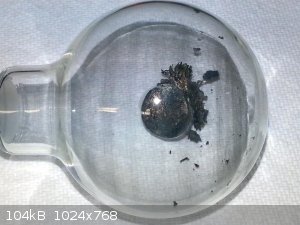 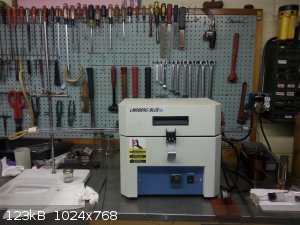 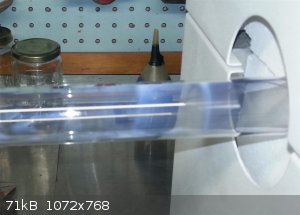 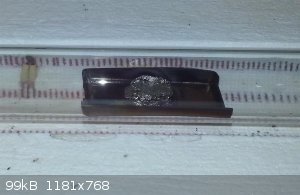 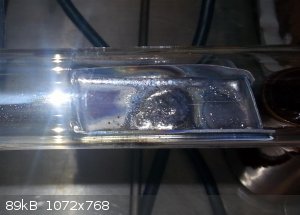
[Edited on 1/28/2017 by Dan Vizine]
"All Your Children Are Poor Unfortunate Victims of Lies You Believe, a Plague Upon Your Ignorance that Keeps the Youth from the Truth They
Deserve"...F. Zappa
|
|
|
tsathoggua1
Hazard to Others
  
Posts: 335
Registered: 8-1-2017
Location: Beyond the pale
Member Is Offline
Mood: Phosphorescent
|
|
You could obtain tantalum foil from tantalum capacitors, never opened one, but then again, I've never needed to.
Apparently those caps have a reputation for going off with quite a bang too, if overcharged.
|
|
|
Dan Vizine
National Hazard
   
Posts: 628
Registered: 4-4-2014
Location: Tonawanda, New York
Member Is Offline
Mood: High Resistance
|
|
They contain tantalum powder formed into porous compacts.
Just because the Eu is condensed on it, doesn't mean the molten metal won't wet it.
There is just so little information on this. If nothing else, I'll try Ta. I'm sure I can find a little sheet somewhere. It would be much more
formable than Mo (which I'm not even sure was ever a "melt").
"All Your Children Are Poor Unfortunate Victims of Lies You Believe, a Plague Upon Your Ignorance that Keeps the Youth from the Truth They
Deserve"...F. Zappa
|
|
|
elementcollector1
International Hazard
    
Posts: 2684
Registered: 28-12-2011
Location: The Known Universe
Member Is Offline
Mood: Molten
|
|
Quote: Originally posted by Dan Vizine  | They contain tantalum powder formed into porous compacts.
Just because the Eu is condensed on it, doesn't mean the molten metal won't wet it.
There is just so little information on this. If nothing else, I'll try Ta. I'm sure I can find a little sheet somewhere. It would be much more
formable than Mo (which I'm not even sure was ever a "melt"). |
Drat! If I were at home right now, I could send you one. Anyway, you've probably already searched and found it, but this is the cheapest I found at a
cursory glance:
http://www.ebay.com/itm/Pure-Tantalum-metal-foil-element-sam...
Elements Collected:52/87
Latest Acquired: Cl
Next in Line: Nd
|
|
|
Dan Vizine
National Hazard
   
Posts: 628
Registered: 4-4-2014
Location: Tonawanda, New York
Member Is Offline
Mood: High Resistance
|
|
I retract what I said, I guess at one time they actually DID use Ta foil.
Wow, that is thin stuff. 0.02 mm? Thanks EC, I was planning on looking. Maybe I'll look a little more.
[Edited on 1/28/2017 by Dan Vizine]
"All Your Children Are Poor Unfortunate Victims of Lies You Believe, a Plague Upon Your Ignorance that Keeps the Youth from the Truth They
Deserve"...F. Zappa
|
|
|
Dan Vizine
National Hazard
   
Posts: 628
Registered: 4-4-2014
Location: Tonawanda, New York
Member Is Offline
Mood: High Resistance
|
|
Well, impatience got the best of me. The remaining chunk of consolidated dentrites was loaded onto another Mo sheet and heated for 15 minutes at 815 C
(11 C below the literature mp). A considerable amount of grey and grey-black material condensed in the cool part of the tube. After cooling to RT in
flowing Ar, the recovered chunk was quick brushed with a metal brush and now appears as shown. It's progress.
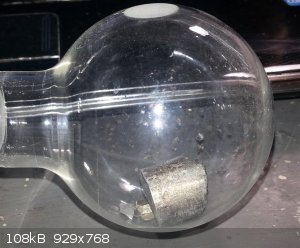
"All Your Children Are Poor Unfortunate Victims of Lies You Believe, a Plague Upon Your Ignorance that Keeps the Youth from the Truth They
Deserve"...F. Zappa
|
|
|
Metacelsus
International Hazard
    
Posts: 2531
Registered: 26-12-2012
Location: Boston, MA
Member Is Offline
Mood: Double, double, toil and trouble
|
|
I wonder if europium would react with a graphite crucible. It might be worth a try.
|
|
|
Dan Vizine
National Hazard
   
Posts: 628
Registered: 4-4-2014
Location: Tonawanda, New York
Member Is Offline
Mood: High Resistance
|
|
The reactivity of europium is similar to the alkaline earths, and you don't melt Ba or Ca in C because of the resulting carbide formation. Turns out,
europium forms one too, EuC2.
Btw, the handling of europium is like much like handling something like Ca or Ba. It discolors in air much quicker than Ca gets powdery but slower
than Ba turns grey-black. They all melt in the same neighborhood. They are all moderately soft, similar to lead.
"All Your Children Are Poor Unfortunate Victims of Lies You Believe, a Plague Upon Your Ignorance that Keeps the Youth from the Truth They
Deserve"...F. Zappa
|
|
|
Dan Vizine
National Hazard
   
Posts: 628
Registered: 4-4-2014
Location: Tonawanda, New York
Member Is Offline
Mood: High Resistance
|
|
And the winner...tantalum.
Attachment: Evaporation of Different Metals.pdf (331kB)
This file has been downloaded 585 times
Attachment: The mystery of molten metal.pdf (911kB)
This file has been downloaded 1588 times
Attachment: REM_presentation_ShortForm.pptx (6.3MB)
This file has been downloaded 381 times
Attachment: Fundamental issues of reactive wetting by liquid metals.pdf (2.8MB)
This file has been downloaded 500 times
[Edited on 1/29/2017 by Dan Vizine]
Attachment: phpSkFIjT (1.2MB)
This file has been downloaded 472 times
"All Your Children Are Poor Unfortunate Victims of Lies You Believe, a Plague Upon Your Ignorance that Keeps the Youth from the Truth They
Deserve"...F. Zappa
|
|
|
Dan Vizine
National Hazard
   
Posts: 628
Registered: 4-4-2014
Location: Tonawanda, New York
Member Is Offline
Mood: High Resistance
|
|
To condense what I got from the references, you can say this about liquid metal - solid metal interactions:
1) Above a relatively low temperature, all pure metals and homogeneous alloys are wetted by molten metals. This temperature tops out at a mere 300 -
400 C for most metals. So, at 800+ C wetting is going to happen no matter what.
2) There are two kinds of wetting. Reactive wetting describes the situation where a new phase, an intermetallic, is formed. This contaminates the
molten metal.
3) The other kind, non-reactive wetting is like a soldered bond. It can be peeled apart. And that is how the Ames lab did it. A crucible is made from
Ta foil, and when molten REs melt in it and then cool, the Ta is removed by peeling. No contamination of the RE results.
Since the sample is small, a thin Ta sheet can be fashioned into a small boat without welding.
The question arises "what's the dark stuff that seems to leave the sample and deposit on the tube?"
Is it Eu? No, untouched by hot running water.
The carbonate is yellow, the oxide/hydroxide white and this is black.
One thing that observation teaches us is that reactive metal nitrides are frequently black, such as lithium nitride or barium nitride. Europium forms
a nitride, EuN. The structure is striking.
Picture graphite, in each ring Eu and N alternate. Each N connects to 3 Eu's and each Eu connects to three N's. Each atom has 4 bonds, the Eu carries
a negative charge and the N carries a positive.
I think, although I haven't found references yet, that EuN is volatilizing off the Eu. It's hard to reconcile that structure with volatility, though.
[Edited on 2/1/2017 by Dan Vizine]
"All Your Children Are Poor Unfortunate Victims of Lies You Believe, a Plague Upon Your Ignorance that Keeps the Youth from the Truth They
Deserve"...F. Zappa
|
|
|
Dan Vizine
National Hazard
   
Posts: 628
Registered: 4-4-2014
Location: Tonawanda, New York
Member Is Offline
Mood: High Resistance
|
|
My apologies about a couple of those downloads. These are the defective ones but they're fixed now.
Attachment: The mystery of molten metal.pdf (911kB)
This file has been downloaded 500 times
Attachment: Wetting by Liquid Metals - Application in Materials Processing.pdf (1.2MB)
This file has been downloaded 471 times
"All Your Children Are Poor Unfortunate Victims of Lies You Believe, a Plague Upon Your Ignorance that Keeps the Youth from the Truth They
Deserve"...F. Zappa
|
|
|
Brain&Force
Hazard to Lanthanides
    
Posts: 1302
Registered: 13-11-2013
Location: UW-Madison
Member Is Offline
Mood: Incommensurately modulated
|
|
Couple of notes:
1) Europium(III) oxide and europium(III) carbonate are both white. Europium(II) oxide is yellow. Interestingly, europium(III) oxide has a lower
reduction potential than europium(II) oxide (just under two volts, which is actually the lowest of all the lanthanides!). I'm pretty sure there is a
mixed Eu3O4 but I have no idea if it forms spontaneously in air. Europium(II) oxide will slowly oxidize to the higher oxide on
air exposure for long periods, or more rapidly on exposure to water.
2) Eu does form intercalation compounds with graphite (EuC6 is a common one). Might be an interesting reducing agent; but I don't know if
direct reaction of Eu and graphite will work, or if the stuff is anywhere close to air-stable. The prep methods I've seen use a lithium-europium
alloy, though.
At the end of the day, simulating atoms doesn't beat working with the real things...
|
|
|
Dan Vizine
National Hazard
   
Posts: 628
Registered: 4-4-2014
Location: Tonawanda, New York
Member Is Offline
Mood: High Resistance
|
|
Thanks for correction on the color of the carbonate and oxide even though it's somewhat of an academic distinction for the purpose of this thread.
My goals are somewhat more simplistic. You can easily find discussions of chemical characteristics of elements, the thermodynamic properties,
reduction potentials, compounds, etc. What you often find lacking in the literature is actual handling, purification and manipulation details. Eg.,
how to make and preserve shiny barium, etc.
This thread hopes to develop an efficient way to turn blackened, dendritic, oil-soaked material into a silver colored ingot. Not sexy stuff, just
useful.
The Ta foil finally arrived today. I fashioned a crucible by folding. The foil is 0.1 mm and work-hardened. The crucible holds acetone without
leaking. Hope it hold up during the planned heating.
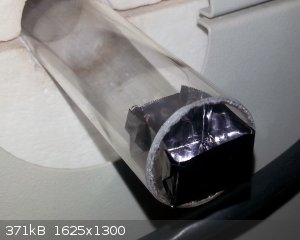
"All Your Children Are Poor Unfortunate Victims of Lies You Believe, a Plague Upon Your Ignorance that Keeps the Youth from the Truth They
Deserve"...F. Zappa
|
|
|
Dan Vizine
National Hazard
   
Posts: 628
Registered: 4-4-2014
Location: Tonawanda, New York
Member Is Offline
Mood: High Resistance
|
|
The quartz tube was flushed with argon for 10 minutes. The crucible was inserted and the argon flow was continued. The tube furnace was heated to 850
C and the crucible was baked for 15 minutes. After cooling under an argon flow, I reached in with tweezers to remove the crucible. The metal shattered
like thin glass. I'm going to have to find another option.
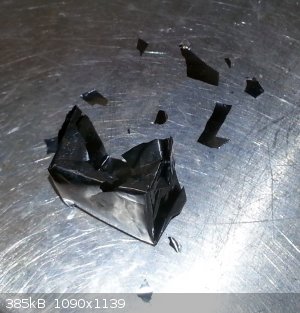
"All Your Children Are Poor Unfortunate Victims of Lies You Believe, a Plague Upon Your Ignorance that Keeps the Youth from the Truth They
Deserve"...F. Zappa
|
|
|
chornedsnorkack
National Hazard
   
Posts: 521
Registered: 16-2-2012
Member Is Offline
Mood: No Mood
|
|
Does europium(II)carbonate exist?
|
|
|
wg48
National Hazard
   
Posts: 821
Registered: 21-11-2015
Member Is Offline
Mood: No Mood
|
|
Quote: Originally posted by Dan Vizine  | | The quartz tube was flushed with argon for 10 minutes. The crucible was inserted and the argon flow was continued. The tube furnace was heated to 850
C and the crucible was baked for 15 minutes. After cooling under an argon flow, I reached in with tweezers to remove the crucible. The metal shattered
like thin glass. I'm going to have to find another option. |
Do you know why the crucible became so brittle?
I would assume it was oxidised? The only way I can think of to easily determine that would be to have weighed it before and then after or measuring
its thickness. Similarly it’s thickness or electrical resistance.
Of cause if it was oxidised your europium would have been oxidised too.
|
|
|
j_sum1
Administrator
       
Posts: 6218
Registered: 4-10-2014
Location: Unmoved
Member Is Online
Mood: Organised
|
|
Quote: Originally posted by Dan Vizine  | | The quartz tube was flushed with argon for 10 minutes. The crucible was inserted and the argon flow was continued. The tube furnace was heated to 850
C and the crucible was baked for 15 minutes. After cooling under an argon flow, I reached in with tweezers to remove the crucible. The metal shattered
like thin glass. I'm going to have to find another option. |
Not a good result. 
My guess is a grain boundary embrittlement of some sort. I doubt argon would do that. But maybe something in your setup diffused along the grain
boundaries at 850C. The alternative is that your Ta is not the quality and purity that you need and just isn't up to the job. Hard to conceive
though. Ta and Ta alloys are normally great refractory metals.
|
|
|
Dan Vizine
National Hazard
   
Posts: 628
Registered: 4-4-2014
Location: Tonawanda, New York
Member Is Offline
Mood: High Resistance
|
|
j_sum1,
I agree with your speculation as to the cause. Ta should laugh at 850 C in UHP argon.
This tantalum wasn't what I expected in to be right from the get-go. Not that I don't believe it's Ta. But, I believe the normal physical
characteristics had been altered by the extreme stress of rolling it to 1 mil. I expected a metal which would exhibit the excellent ductility normally
associated with Ta. Instead, the foil was so hard that if you made a sharp edge bend and tried to flatten the foil to change the geometry, it would
crack at the bend.
Maybe this was rolled from the 90% dense powder metallurgy product instead of arc-melted metal? Anyway, it's interesting but useless to speculate.
Too bad that was the only present eBay listing for Ta foil/sheet. I'll just have to wait until something better gets listed.
This experience serves to illustrate a principle which I have always adhered to. Whenever a new crucible is being used for anything, heating it to the
working temperature before using it is mandatory. I never expected this. If anything, I expected the foil may be annealed by the heat. If the crucible
had failed with 20 g of molten europium in it, it would have been goodbye to over $200 worth of metal, the quartz reaction tube and quite possibly
damage to the tube furnace.
chornedsnorkack, Yes, europium carbonate exists, but it isn't Eu(II), it's Eu(III).
wg48, I'm really careful when it comes to oxygen exclusion. Hence, my tank of 99.999% argon. Throughout much of my working career that has been an
essential skill, given my synthetic targets. The Ta crucible is still mirror-bright, not a hint of oxidation visible to the naked eye.
Added note: I was just reviewing some of Ta's characteristics.
Elongation, 35% (great)
Elongation of worked metal (95 % redn.), 5% (poor)
Hardness, recrystallized, 90 DPN
Hardness of worked metal (95 % redn.), 200
Recrystallization temp. 1300 C
I now see the error of my ways. Heavily work-hardened Ta is not ductile and it won't become ductile until it is heated to 1300 C in argon, which I
can't do. That's at least 100 C above my hottest furnace, and 200 C above the tube furnace.
[Edited on 2/19/2017 by Dan Vizine]
"All Your Children Are Poor Unfortunate Victims of Lies You Believe, a Plague Upon Your Ignorance that Keeps the Youth from the Truth They
Deserve"...F. Zappa
|
|
|
Fleaker
International Hazard
    
Posts: 1252
Registered: 19-6-2005
Member Is Offline
Mood: nucleophilic
|
|
Dan,
Your Ta looks really dark to me. Are you sure it isn't molybdenum?
I work with many forms of tantalum on a daily/production basis. Tantalum's ductility when pure is much like copper, insofar as rolling is concerned,
but it is extremely sensitive to interstitial impurities like C, H, N, and O which embrittle it. Electron beam remelted Ta is frequently used for
making foil--it is very very rarely remelted with an arc. Tantalum is also such a lover of oxygen that it will remove the O from SiO2 (or even Al2O3).
Surely 15 minutes is not really long enough to have silicon mobile enough to diffuse through the metal?
Ta should indeed laugh at at 850 C in argon. It laughts at 2200 C in vacuo. Was there any possible way that H got into your setup? Hydrogen will make
tantalum break like stale potato chips.
You can get Ta or iridium crucibles to do this in. Even platinum might work?
Neither flask nor beaker.
"Kid, you don't even know just what you don't know. "
--The Dark Lord Sauron
|
|
|
Dan Vizine
National Hazard
   
Posts: 628
Registered: 4-4-2014
Location: Tonawanda, New York
Member Is Offline
Mood: High Resistance
|
|
Hi Fleaker,
Nice to hear from our resident walking rare metals encyclopedia!
Well, all that I can say with authority is that the eBay seller said it was Ta, no COA or anything.
The metal colors are hard to reproduce faithfully, but the picture below at least allows comparison (to the extent that surface finish doesn't
interfere). I'd be hard pressed to offer a meaningful comment.
Yes, similar to copper was what I somehow anticipated. I don't know how any hydrogen could have intruded. I wonder if skin oil might play a part. The
metal isn't uniformly brittle everywhere.
Since the metal will be allowed to cool in the crucible and the crucible will be physically torn off it, platinum and iridium are less desirable. I
think Ta deserves another go if I can locate ductile material. Ductility is key to peeling the Ta off, as in the Ames labs work referenced above.
The SiO2 reactivity is something I hadn't considered. But, as you said, 15 minutes wouldn't seem enough. Still...
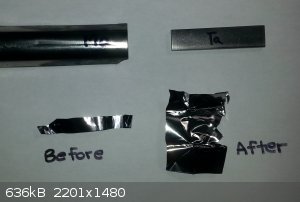
[Edited on 2/19/2017 by Dan Vizine]
"All Your Children Are Poor Unfortunate Victims of Lies You Believe, a Plague Upon Your Ignorance that Keeps the Youth from the Truth They
Deserve"...F. Zappa
|
|
|
Dan Vizine
National Hazard
   
Posts: 628
Registered: 4-4-2014
Location: Tonawanda, New York
Member Is Offline
Mood: High Resistance
|
|
After unfolding the crucible, it was found to be composed of two types of material. The blue area is fragile, you could break it with a drinking
straw. The other parts are the same springy, hard foil I started with. It must have been surface contamination. Try again.
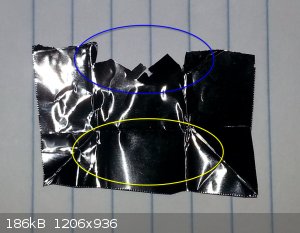
"All Your Children Are Poor Unfortunate Victims of Lies You Believe, a Plague Upon Your Ignorance that Keeps the Youth from the Truth They
Deserve"...F. Zappa
|
|
|
chornedsnorkack
National Hazard
   
Posts: 521
Registered: 16-2-2012
Member Is Offline
Mood: No Mood
|
|
Does not mean Eu(II)carbonate does not also exist!
CaO (quicklime) reacts in air:
CaO+H2O=Ca(OH)2
Ca(OH)2+CO2=CaCO3+H2O
SrO and BaO would react the same way.
EuO has potentials for side reactions that CaO does not have:
4EuO+O2=2Eu2O3
4Eu(OH)2+O2=2Eu(OH)3+2EuOOH
But seeing how strong reducer Eu(II) is, even hydrogen can be reduced:
2Eu(OH)2=2EuOOH+H2
Now, can Eu(OH)2 react with CO2, forming EuCO3?
In a mixture of Eu(OH)2 and Eu(OH)3, Eu(OH)2 is the stronger base.
|
|
|
Dan Vizine
National Hazard
   
Posts: 628
Registered: 4-4-2014
Location: Tonawanda, New York
Member Is Offline
Mood: High Resistance
|
|
chornedsnorkack,
Point well taken. In fact, Eu (III) can be reduced in aqueous solution to Eu (II). A number of salts are known, including the carbonate.
[Edited on 2/20/2017 by Dan Vizine]
"All Your Children Are Poor Unfortunate Victims of Lies You Believe, a Plague Upon Your Ignorance that Keeps the Youth from the Truth They
Deserve"...F. Zappa
|
|
|
chornedsnorkack
National Hazard
   
Posts: 521
Registered: 16-2-2012
Member Is Offline
Mood: No Mood
|
|
Are Eu(OH)2 and EuCO3 yellow?
|
|
|
Dan Vizine
National Hazard
   
Posts: 628
Registered: 4-4-2014
Location: Tonawanda, New York
Member Is Offline
Mood: High Resistance
|
|
I read in one source that the carbonate is yellow, but I was corrected (above). I haven't checked on the oxides.
"All Your Children Are Poor Unfortunate Victims of Lies You Believe, a Plague Upon Your Ignorance that Keeps the Youth from the Truth They
Deserve"...F. Zappa
|
|
|
| Pages:
1
2 |